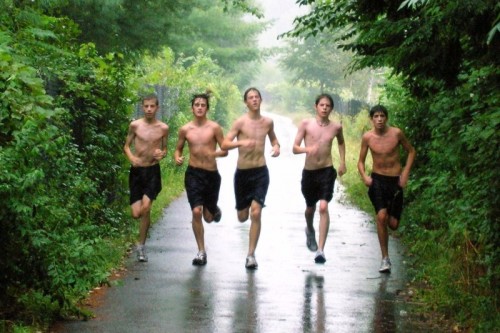Children’s Jogging
Increasing numbers of children are participating in organized distance running – jogging. Some ambitious parents have sought to enter their children in adult type marathon races and there is even an occasional child who can “succeed” in this type of activity.
High school track team out for a run in the mist
Jogging With Children
Because of the increasing danger to the growing child participating in adult type marathon events, the American Academy of Pediatrics has issued an official statement against it.
Several years ago the academy stated that there was reason to have fear of the effects of micro-trauma on the growth centers of long bones during children’s competitive running.
They denounced extreme forms of competitive running for children; and children are excluded (appropriately so) by organizers from many marathon races.
I am encouraged, however, by a recent article in, “Physician and Sports Medicine” which described a race designed specifically with the physical, intellectual, and emotional needs of children taken into account.
There are several things that should be taken into consideration in designing any type of children’s sport activity.
The growth centers in the long bones of children are working very hard to create new bone formation adn are most vulnerable to injury.
The overuse and abuse of a child’s physical nature which occurs in continually trying to “outdo someone else” can lead to small microscopic areas of fracture in the growth plate.
This, then, can lead to uneven bone growth as well as growth failure.
Everyone know that a child seems to be able to “go forever”. Even untrained children often have a surprising capability for the aerobic type of endurance events.
Although their ability to utilize oxygen is low, their aerobic power related to their weight exceeds that of an adult.
Children, however, pay the price of shorter stride and immature running styles and their running efficiency is less than that of an older person.
On treadmill resting, however, a 10 year old boy can be expected to have an endurance time similar to a 25 year old untrained man, and a 6 year old girl will exceed that of a 25 year old woman.
Children are at particularly high risk for heat stress during exercise. It is well-known that children do not dissipate heat well at all and are highly susceptible to hear build-up.
In addition, they generate more heat for a given activity than do adults, as well as perspiring less.
The emotional aspects should also be considered. Emphasis should be placed nearly entirely on individual effort rather than winning.
Fun, enjoyment, and participation are highly priced aspects; where coming in first, for children under 12, should not be held up as the ultimate goal.
Entrance fees should not be prohibitive, and sponsorship must be carefully considered.
One race had an offer from a local tavern for free t-shirts if their name was inscribed on the back. This offer was promptly and appropriately not considered.
Children’s Race Design
An appropriate design of a race for children under 12 should best consist of the following:
- The course should be flat and between one and two miles of duration.
- The race should be in the cool of the day and the course should be largely shaded.
- The course should have adult supervision continually and should be completely free of vehicular traffic and obstacles.
- 8 – 12 ounces of fluid should be ingested prior to racing, 2 – 4 ounces half way through, and unlimited fluids following the race along with a light meal.
- Only those who have participated in an educational program about proper warm-up, ingestion of fluids, and racing strategy should be allowed to participate.
- Prizes should be individualized and reflect appropriate standards for children.
This type of an activity is an ideal opportunity for education in proper training techniques. Warm-up exercises, training techniques, shoes, nutrition, prevention of heat stress all should be discussed.
The concept of pacing is foreign to most children but in endurance competition it is key.
Jack-rabbit starts lead rapidly to fatigue in children because they tolerate high intensity and aerobic work even more poorly than do adults.
Of course, before participation in any competitive event the child’s physician should be consulted especially regarding any currently existing medical problems like asthma, diabetes, and others.
Advertisement by Google
(sorry, only few pages have ads)

